|
1.
CENTRAL AND WEST AFRICA
Importers adopting alternative sourcing strategies
There have been no major shifts in timber prices since late
2024. European buyers, driven by compliance
requirements, continue to adapt sourcing strategies. A
growing number of European importers are turning to
sawnwood suppliers in the Democratic Republic of the
Congo, Liberia and Equatorial Guinea. This preference for
sourcing processed timber rather than logs benefits West
African mills that can demonstrate legal and sustainable
production.
Azobé (Ekki) remains in regular demand for infrastructure
projects in the EU and many European firms now opt to
buy sawn sizes directly from West Africa to meet strict
legality requirements.
Producers say any significant rebound in demand depends
heavily on an upturn in the Chinese market. China’s
timber demand remains notably sluggish, largely due to
decreased housing construction and an oversupply of
apartment units. As Chinese mills grapple with slow
domestic demand West African timber producers see
fewer orders.
Developments in Gabon, Cameroon and Congo
Gabon is in a seasonal dry period though intermittent rains
every few days still affect logging activities, particularly in
up-country areas. Road transport is slow through regions
like Lastourville, Lopé and Makokou where hauling
timber to Owendo port can take days. Ongoing work on
the Ndjolé-Bifoun route and other key arteries are
essential for connecting northern, eastern and southern
Gabon with Libreville but persistent rains and budget
constraints hamper progress.
Okoume remains the core species for local production
with peeler logs priced around 65,000 FCFA per cubic
metre delivered to the Nkok Special Economic Zone.
Premium CS-grade Okoume can reach 70,000 FCFA
while sawing-grade logs are now at 50,000 FCFA per
cubic metre delivered.
China’s reduced imports continue to dampen Gabon’s
timber exports. The Philippines remains a consistent buyer
of Okoume and Dabema, while Vietnam sustains interest
in Tali. Some improvement was noted in the Middle East
with modest inquiries for Andoung, Iroko, Padouk, Tali
and Okoume.
Controversy surrounds the government’s plan to label each
bundle of sawn timber with log origin GPS data. Millers
highlight practical challenges including how forestry
officers would verify felling deep in the bush.
Gabon is one of Africa’s largest timber exporters and a
major producer of veneer particularly for Chinese, Indian
and Vietnamese manufacturing.
Libreville continues to experience daily power outages.
The ongoing power cuts disrupt production and there are
reports of power surges causing damage electronics.
Gabonese sawmills are reported to be operating at around
40% capacity due to power outages.
The previous administration signed an agreement with a
Turkish company to bring in two power-generating
vessels. Authorities recently convened a group of
ministers, national power utility officials and petroleum
sector managers to review the contract conditions.
Harvesting activities have resumed across Cameroon,
coinciding with the beginning of the dry season that
typically lasts until June. However, production remains
subdued due to lackluster international demand. China’s
notably reduced timber imports have dampened output, the
overall market sentiment is low to stable.
Despite a return to normal trucking and railway
operations, production remains below potential as mills
choose to limit output in response to weak demand and
stringent government controls.
Strict enforcement of CFAD (Forestry Concession
Allocation Decree) regulations has significantly reduced
exports with some shipping company representatives
indicating a 50% drop in timber exports from Cameroon.
Government efforts to enforce strict regulations have
prompted some Asian operated mills to shut down, at least
temporarily. Estimates suggest roughly half of these mills
are currently closed. While this crackdown is part of a
broader push for responsible forestry practices, it also
reduces available production capacity.
Log inflows from northern Congo and the Central African
Republic remain low.
Looking ahead, the dry season may allow operators to
ramp up production but real growth hinges on improved
international demand, especially from China and
continued policy consistency. For now, Cameroon’s
timber sector navigates a climate of cautious activity,
hoping for more favorable conditions as the year
progresses.
Harvesting conditions in northern Congo have improved
with the cessation of rains, though production remains
below peak levels due to subdued demand in Asia and
Europe. Many operators continue to transport logs and
sawnwood to Douala in Cameroon which can be more
convenient than Pointe-Noire for northern producers
despite long stretches of unpaved roads. Transport to the
south, especially to Pointe-Noire, benefits from existing
tarmac roads and log parks in Maloukou.
However, the railway from Brazzaville to Pointe-Noire
remains in poor condition and it is reported the
government is seeking investment for its overhaul.
Meanwhile, direct trucking to Pointe-Noire remains a
viable option for producers near the coast, ensuring steady
port operations.
Producers report export order levels are stable to low. The
Philippines continues to purchase Okoume sawnwood,
while Tali exports to Vietnam provide a degree of
consistency. China’s demand, once a primary driver for
Congolese timber, has weakened with lower volumes and
prices. Some species preferred in Europe maintain some
niche appeal in Asia but local operators must navigate
strict regulations and competition from other West African
suppliers.
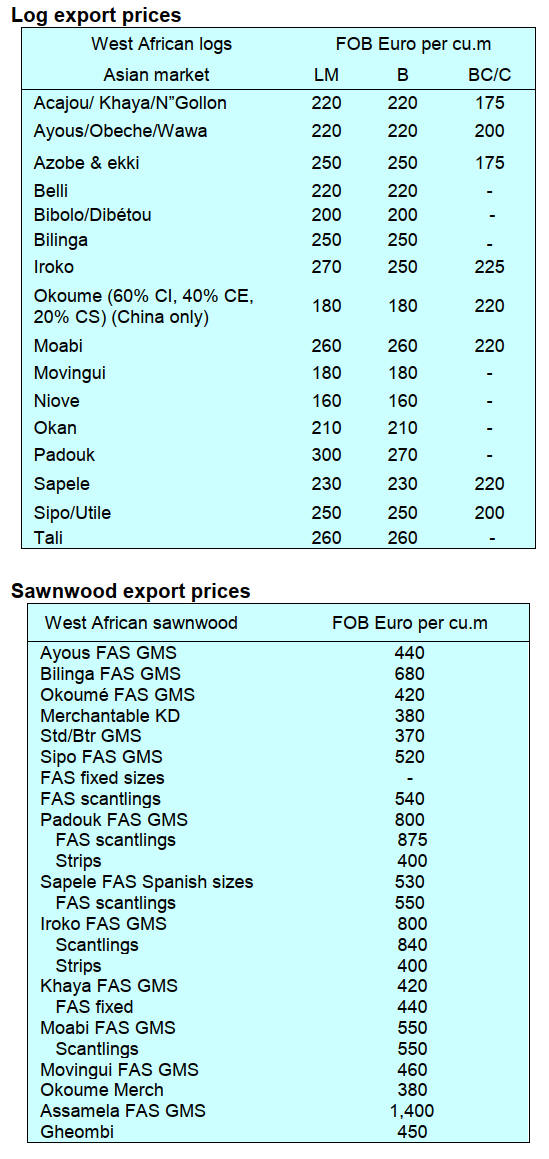
Through the eyes of industry
The latest GTI report lists the challenges identified by the
private sector in the Republic of Congo and Gabon.
See:
https://www.itto-
ggsc.org/static/upload/file/20250116/1737011307133693.pdf
2.
GHANA
Sawnwood dominated export trade but volume
dipped
Ghana’s 10-months wood products exports for 2024
earned the country Eur103.94 million from a total volume
of 231,491 cu.m. This compared to the same period the
previous year showed a decline of 7% and almost 9% by
volume and value respectively according to Timber
Industry Development Division (TIDD) data.
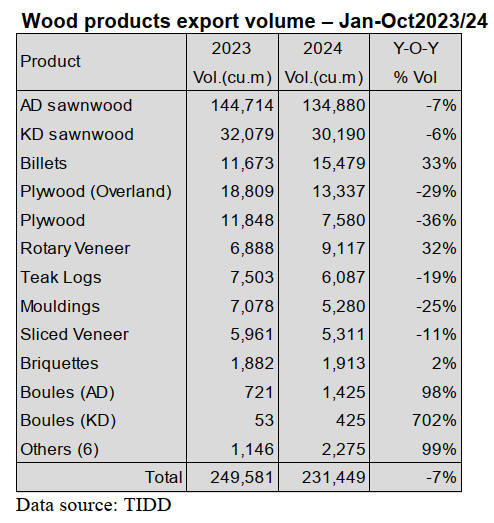
Billets, rotary veneer, briquettes, air-dried boules and kiln-
dried boules recorded significant export volume growth in
the 10 months of 2024 against 2023 for the same period.
However, the overall 2024 performance was low due to
poor demand for some products in Europe, Africa and the
Middle East .
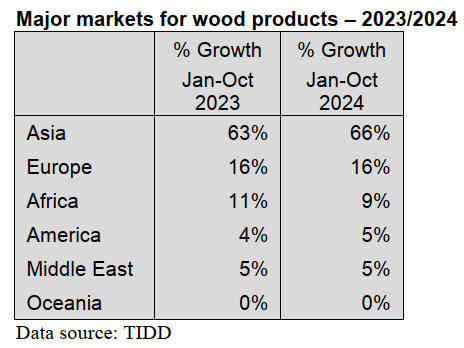
During the first ten months of 2024, tertiary product
exports earned Eur5.03 million compared to Eur6.23
million in the same period of 2023.
Secondary products generated a total of Eur37.86 million
(January to October 2024) against Eur42.77 million for the
same period in 2023. Asia accounted for 153.137 cu.m,
representing 66% of the total export volume in 2024,
(Eur59.00 million).
Average unit prices in 2024 for gmelina, avodire, black
ofram, ogea, niangon essa/celtis and tetekon decreased
year on year. The average unit price for wood product
exports saw a slight decrease of around 2% from
Eur457/cu.m in January to October 2023 to Eur449/cu.m
in the same period of 2024.
Former Minister of Energy to head the Ministry of
Lands and Natural Resources
The President, John Mahama, has nominated Emmanuel
Armah-Kofi Buah as Minister-designate for the Ministry
of Lands and Natural Resources (MLNR). Mr. Buah was
the Minister of Energy and Petroleum in the 2013 to 2016
administration.
According to the newly appointed Minister, the healing of
the country’s water bodies and legal and safe mining will
be his top priorities. He has therefore pledged to work
tirelessly to protect and manage the country’s lands and
natural resources effectively.
At a Parliamentary Ministerial vetting he also vowed that
when directed, he will revoke Legislative Instrument (LI)
2462 (Mining in Forest Reserves) to save the country’s
water bodies, tracks of farms from environmental
degradation.
The Chief Executive of the Forestry Commission (FC),
John Allotey, bade farewell to the staff of the Commission
marked by heartfelt speeches and reflections on the
journey he had during his tenure with the organisation.
At a durbar in his honour, he acknowledged the frontline
staff of the forest guards and rangers, whose unwavering
dedication had been the backbone of the achievements
chalked by the Commission. He emphasised that the
foundation they have all built together will continue to
support the mission of the Forestry Commission.
See:
https://www.ghanaweb.com/GhanaHomePage/business/Healing-
our-water-bodies-legal-mining-safe-mining-my-top-priorities-
Armah-Kofi-Buah-1969146
and
https://fcghana.org/c-e-bids-fc-farewell/
Survey reveals businesses optimistic on economic
prospects
A survey report by the UK-Ghana Chamber of Commerce
(UKGCC) has revealed businesses are optimistic about the
potential growth opportunities in the country but have
called for urgent reforms to address challenges hindering
economic progress.The 2024 UKGCC Business
Environment and Competitiveness Survey report revealed
that, while businesses are cautiously optimistic about
future growth particularly in technology adoption and
market expansion significant challenges remain
unresolved.
The study surveyed 725 businesses, comprising UKGCC
member and non-member companies from 22 industries.
The findings identified taxation policy, the cost of
telecommunications, government bureaucracy and the
regulatory framework as the top concerns for businesses in
2024.
The report also identified that the manufacturing sector is
embracing digital tools to enhance productivity and reduce
operational inefficiencies. However, the timber
manufacturing sector, which is a cornerstone of the
country’s economy, continues to face high production
costs, including raw material costs and access to financing.
In a related development, the latest Stanbic Bank Africa
Trade Barometer (SB ATB) rankings highlighted growing
trade challenges in the country. These included
deteriorating perceptions of trade-related factors such as
border efficiency in relation to Customs efficiency and
high taxes, infrastructure quality (telecom, road, power),
access to finance and governance.
Meanwhile, a Bank of Ghana (BoG) survey in December
2024 also showed an improvement in both consumer and
business confidence as economic growth remains strong.
See: https://thebftonline.com/2025/01/23/businesses-optimistic-
about-growth-call-for-urgent-reforms-report/
and
https://thebftonline.com/2024/11/13/trade-competitiveness-slips-
amid-challenges-report/
and
https://www.myjoyonline.com/business-consumer-confidence-
improves-economic-growth-remains-strong-bog/
Central Bank steady on interest rates
The Monetary Policy Committee of the Bank of Ghana
(BoG) has kept its key lending rate to commercial banks
unchanged at 27% after meeting to review developments
in the economy over the past two months. The Governor
of the Bank of Ghana Dr. Ernest Addison attributed this to
a steady decline and return to the path of dis-inflation.
See: https://www.bog.gov.gh/wp-
content/uploads/2025/01/Summary-of-Economic-and-Financial-
Data-January-2025.pdf
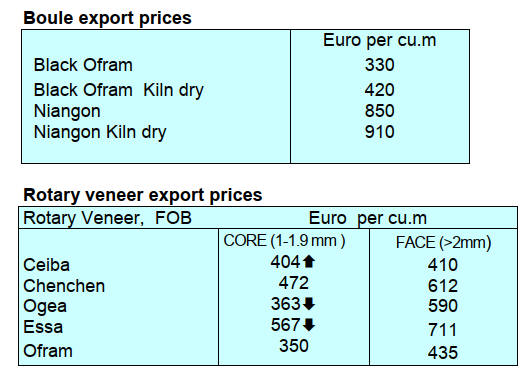 
Through the eyes of industry
The latest GTI report lists the challenges identified by the
private sector in Ghana.
See: https://www.itto-
ggsc.org/static/upload/file/20250116/1737011307133693.pdf
3. MALAYSIA
Low interest may boost domestic houing demand
Bank Negara Malaysia has announced that it is keeping
interest rates unchanged at 3% as this is deemed to be
supportive of the economy and consistent with the current
assessment of inflation and growth prospects.
Analysts are of the opinion that maintaining the rate at 3%
(where it has been since May 2023) may encourage more
people to consider purchasing their own homes, especially
as the minimum wage will be increased from 1 February
along with the recent 13% plus raise for civil servants.
The real estate sector may see expansion due to growth in
the construction sector and increased foreign direct
investments (FDIs).Malaysia's total property transaction
value surpassed RM105 billion in the first half of 2024
with 198,906 transactions recorded, marking the highest
growth in value and volume over the past five years
according to the 2024 First Half Property Market Report
by the National Property Information Centre (Napic).
See:
https://www.nst.com.my/property/2025/01/1164644/property-
sector-poised-further-growth-led-higher-fdis-construction-
activity
Malaysia-EU FTAnegotiations to resume
It has been reported that long stalled negotiations for the
Malaysia-EU Free Trade Agreement (MEUFTA) will
resume. In 2023 the EU was Malaysia’s fourth largest
trading partner with trade reaching RM206.79bil.
For the period of January to November last year trade with
the EU grew by 5% to RM200bil. compared to the same
period in 2023. As of 2023 the domestic press reports EU
investments in Malaysia have generated over 153,000 jobs
through 1,323 projects valued at RM227.9bil.
See:
https://www.thestar.com.my/news/nation/2025/01/20/malaysia-
eu-resume-negotiations-for-landmark-free-trade-deal
Potential of bamboo sector to be assessed
The Sarawak Timber Industry Development Corporation
(STIDC) has welcomed the opportunity to collaborate with
the Universiti Malaysia Sarawak (Unimas) bamboo
research in the State. A delegation from Unimas visited
STIDC’s bamboo pilot project in Sabal, Simunjan recently
to see the STIDC bamboo-planting project.
Unimas Deputy Vice Chancellor, Professor Dr. Siti Noor
Linda Taib, said “we see great potential in the bamboo
industry and want to continue to help STIDC develop this
sector so that it can have a positive impact on the economy
of the state of Sarawak.
See:
http://theborneopost.pressreader.com/article/281633900909147
Foreign Workers Transformation Approach
The Sarawak State Government’s Foreign Workers
Transformation Approach (FWTA) system came into
effect in mid-January. The FWTA is an online digital
application designed for processing work permit
applications for non-resident workers. However, many
industrialists have raised concern regarding the fees
involved.
The Sarawak Timber Association (STA) called for FWTA
charges to be deferred until further consultations with all
stakeholders have been conducted. STA CEO, Annie Ting,
pointed out that the sudden implementation has sparked
widespread concerns across various industries.
In a statement Deputy Minister in the Premier’s
Department (Labour, Immigration, and Project
Monitoring) Datuk Gerawat Gala assured stakeholders that
the government remains attentive to their grievances and is
committed to addressing them through further
engagement.
See: https://www.theborneopost.com/2025/01/17/gerawat-
sarawak-govt-open-to-revisiting-fwta-fee-structure-in-response-
to-industry-concerns/
Through the eyes of industry
The latest GTI report lists the challenges identified by the
private sector in Malaysia.
See:
https://www.itto-
ggsc.org/static/upload/file/20250116/1737011307133693.pdf
4.
INDONESIA
Imported furniture is overwhelming the
domestic
market
Dedy Rochimat, the General Chairman of the Indonesian
Furniture and Craft Industry Association (ASMINDO, has
said the inflow of imported furniture into Indonesia
remains a pressing concern for local furniture
manufacturers who fear this may undermine the domestic
furniture industry. According to data from Statistics
Indonesia, furniture imports in the first 10 months of 2024
increased by 16% year on year.
ASMINDO stated “as an organisation representing 90% of
the SME sector ASMINDO is seeking support from the
government to protect domestic manufacturers.
ASMINDO has called for stronger regulatory measures to
control the inflow of furniture imports and an emphasis on
local products in government procurement”.
See: https://www.detik.com/properti/berita/d-7746050/furniture-
impor-banjiri-ri-asosiasi-mebel-minta-pemerintah-lindungi-
pasar-lokal.
Indonesian furniture exports at IDR 36 trillion
The Minister of Trade, Budi Santoso, stated that exports of
Indonesian furniture and craft products earned US$2.22
billion, equivalent to IDR36.07 trillion, between January
and November 2024. Budi noted that Indonesia is
currently ranked 19th in the world as a supplier of
furniture and crafts.
During the launch of IFFINA 2025 Budi said it is
encouraging to see that global demand for furniture and
crafts remains firm and expressed optimism that
Indonesian furniture exports will continue to rise to
achieve the 7% growth target. To achieve this, the
Minister of Trade emphasised the importance of
collaboration among the government, business
stakeholders and associations to boost exports.
See: https://www.antaranews.com/berita/4603254/mendag-sebut-
ekspor-furnitur-indonesia-capai-rp36-triliun
Pellets for South Korea
Indonesia has significant potential in the wood pellet
industry which is experiencing high demand in the
international market. Eko Prilianto Sudradjat, Indonesian
Trade Attaché in Seoul, noted that in S. Korea this trend is
driven by the policy to eliminate the use of coal in power
plants by 2030.
Indonesia currently ranks third in the global wood pellet
market. Vietnam leads the market with a nearly 40%. "The
growing use of bioenergy in S. Korea aligns with the green
energy policy aimed at reducing dependence on fossil
fuels" said Eko.
See: https://www.msn.com/id-id/berita/other/potensi-ekspor-
pelet-kayu-indonesia-untuk-korea-selatan-yang-lebih-hijau/ar-
BB1rmzbM?ocid=BingNewsVerp
Forests to remain intact
Forestry Minister, Raja Juli Antoni, clarified that the
government has no plans to convert 20.6 million hectares
of forest into food and energy plantations. He explained
that the government intends to adopt intercropping
patterns that preserve forests while optimising their
functions.
The approach envisaged, according to Raja Juli, involves
agroforestry which ensures forests are preserved,
ecosystem functions are maintained and food production is
increased. Raja Juli said this initiative aims to achieve
food self-sufficiency.
In related news, forestry sector members of the Indonesian
Forestry Entrepreneurs Association (APHI) welcomed the
plan of Forestry Minister, Raja Juli Antoni, to implement
the Food, Energy and Water Reserve Forest (HCPE)
programme.
APHI Deputy Chairperson, Erwansyah, said in a statement
this programme can also be implemented in the Forest
Utilisation Business Permit (PBPH) areas through a multi-
forestry business model.
He explained that forestry sector businesses have evolved
from the original business licensing based on commodities
(timber for example) to PBPH, namely business licensing
based on site/land potential. As a result businesses can
implement the multi-forestry business model through
utilising the full potential of forests.
See: https://forestinsights.id/implementasikan-multi-usaha-
kehutanan-aphi-sambut-program-hutan-cadangan-pangan-dan-
energi/
and
https://jakartaglobe.id/news/forestry-minister-forests-to-stay-
intact-in-food-and-energy-security-program
and
https://en.antaranews.com/news/341722/govt-pushes-
intercropping-in-forests-for-food-sufficiency
Revoking permits from irresponsible concession
holders
President Prabowo Subianto announced that he will revoke
the permits of non-compliant land and forest companies,
particularly those that have not fulfilled their obligations.
"The government will revoke permits for those who have
had multiple opportunities to fulfill their obligations but
have failed to do so" said Prabowo during a plenary
cabinet meeting in January 2025.
Prabowo emphasised the responsibilities of companies
operating in the forest. He stated that the government
would take control if these companies fail to adhere to the
regulations. The president also directed law enforcement
officials to strictly enforce the rules. He stressed that there
should be no preferential treatment for companies that
violate these regulations.
See:
https://nasional.kompas.com/read/2025/01/22/17092491/prabow
o-bakal-cabut-izin-perusahaan-nakal-pelanggar-aturan
and
https://www.inews.id/news/nasional/tegas-prabowo-akan-cabut-
izin-perusahaan-yang-langgar-ketentuan-tanah-dan-hutan
Task Force to combat forest violations
The Indonesian government, through Presidential
Regulatio Number 5 of 2025, has established a Task Force
to control and protect forest areas. President Prabowo
Subianto formed this task force with a mission: to
eradicate illegal activities within forest areas, improve
land management practices and maximise state revenue
from these resources.
The Forest Area Order Task Force operates directly under
the President's authority. Its organisational structure
includes a Director, led by Defense Minister, Sjafrie
Sjamsoeddin and an Executive body chaired by the
Deputy Attorney General for Special Crimes from the
Attorney General's Office.
The Task Force has the authority to investigate and take
action against illegal activities within forest areas, such as
unauthorised mining and plantation operations. To support
its duties the Task Force can collaborate with academics,
community groups and the private sector.
See: https://en.tempo.co/read/1967220/prabowo-establishes-task-
force-to-combat-forest-area-violations
Indonesia launches international carbon trading
platform
The Indonesian Carbon Exchange (IDXCarbon) officially
launched its first international carbon trading session on
20 January 2025. The launch was overseen by IDXCarbon
President Director, Iman Rahman and Indonesia's Minister
for Environment, Hanif Faisol Nurofiq. The Ministry
hopes the launch will serve as the first step toward
accelerating Indonesia’s Second Nationally Determined
Contributions which will be submitted to the secretariat of
the United Nations Framework Convention on Climate
Change (UNFCCC) in February 2025.
Carbon credits opened at a price of Rp96,000
(approximately US$5.86) per tonne for units under the
Indonesia Technology-Based Solution (IDTBS) category
and Rp144,000 (approximately US$8.80) per tonne for
units under the IDTBS Renewable Energy (IDTBS-RE)
category.
At the launch the Minister of forestry announced the
ministry is preparing a mechanism to facilitate the trading
of carbon from the forestry and other land use (FOLU)
sector.
He noted that this development is an important step in
establishing carbon pricing, including enhancing its
potential in the FOLU sector.
According to the Minister the Ministry of Forestry is
currently preparing a scheme that will hopefully boost
interest in the carbon market," he remarked. The ministry
has consulted with the Financial Services Authority (OJK)
to explore the possibilities for carbon trading based on
emissions reductions in the FOLU sector.
See:https://www.metrotvnews.com/read/NxGCGlxa-pemerintah-
godok-skema-perdagangan-karbon-sektor-pemanfaatan-hutan
and
https://en.tempo.co/read/1966011/indonesia-launches-
international-carbon-trading-platform
BRICS membership could boost exports
Trade Minister, Budi Santoso, said he is optimistic that
Indonesia's inclusion as a full member of BRICS could
increase exports. According to the Center of Economic
and Law Studies (CELIOS) Indonesia's full membership
of the BRICS grouping will provide new benefits,
especially in expanding its export markets.
Indonesia's exports have been focused on traditional
markets such as the US and Europe said CELIOS'
Economic Director, Nailul Huda and joining BRICS will
provide benefits for Indonesia to diversify export markets.
See: https://en.antaranews.com/news/340938/expect-brics-
membership-to-boost-exports-trade-minister
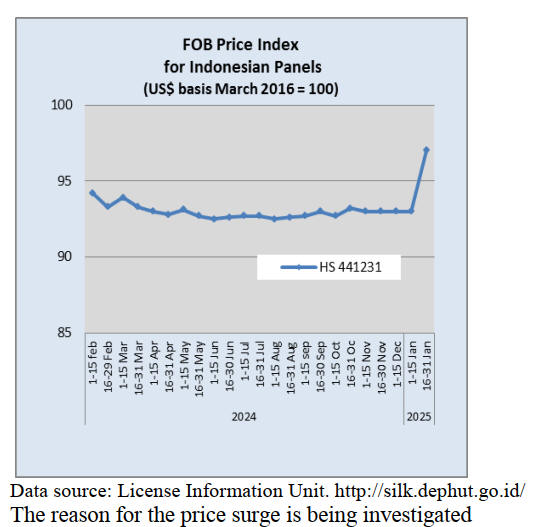
5.
MYANMAR
Myanmar’s timber industry - challenges and strategies
for revival
Recent updates from the Forest Department's official
Facebook page indicate that meetings have been held with
wood-based industries across various regions to discuss
recent regulatory changes.
These efforts aim to revive Myanmar's timber export
sector which has been significantly impacted by denied
access to major international markets.
These activities follow a December 2024 workshop
focusing on forest development, sustainable timber
production, plantations and strengthening wood-based
industries. Manufacturers often cite overly strict regulation
as one of the barriers for the development of timber trade
and exports.
Myanmar's wood-processing sector relies predominantly
on primary processing. This approach yields a diverse
range of sawn products catering to both domestic and
export markets. However, limited specialisation in value-
added or secondary processing has resulted in a
fragmented supply chain.
Until 2015, the Myanma Timber Enterprise (MTE) and
Forest Management Units (FMUs) managed log supplies
from multiple locations across the country. The reduced
active of FMU managers post-2015 reflects a structural
shifts which may result in reduced harvesting quotas,
resource depletion along with governance challenges.
This decentralised approach complicates documentation
and traceability compared to other countries where more
centralised, plantation-based systems dominate.
International assessments of management in Myanmar
often fail to account for Myanmar's unique forestry
context.
Such oversimplified evaluations overlook the complexities
of Myanmar's natural forest dynamics and socio-economic
factors. This underscores the need for tailored frameworks
that recognise the country's decentralised and multifaceted
supply chain.
Myanmar’s timber industry is undergoing significant
transition influenced by resource availability, international
market pressures and evolving policies. The sector is
adapting to global standards such as enhanced traceability.
Achieving this under Myanmar's current socio-political
and economic constraints is challenging.
By focusing on transparency, traceability and sustainable
practices Myanmar could begin to rebuild trust in its
timber industry and navigate its path toward a resilient and
internationally accepted forestry sector.
See - https://forestdepartment.gov.mm/news/28798
Promoting rattan, bamboo and NFTPs
The Union Minister for Natural Resources and
Environmental Conservation has taken steps to advance
the promotion of rattan, bamboo and Non-Timber Forest
Products (NFTP). During his recent visit to a Rattan
Finishing Factory in Yangon Region the Minister
inspected production processes and discussed raw material
use, exports and revenue.
At a meeting with entrepreneurs and officials from wood-
based, rattan and bamboo industries at the Forest Products
Joint Venture Corporation office the Minister emphasised
the importance of supporting small, medium and large-
scale businesses.
He highlighted Myanmar's annual production potential of
318 million bamboo poles and 77 million rattan rods and
mentioned ongoing approvals for private bamboo
plantations. The Minister stressed the need for sustainable
resource use while working to expand exports.
Entrepreneurs were encouraged to explore regional
markets, adopt new technologies and produce export-ready
finished products to drive job creation and economic
growth. The Minister called for strategic planning, private
sector collaboration and improvements in technology,
human resources and raw material access.
A key focus of the initiative is the development of
Myanmar’s first rattan certification system. The Myanmar
Rattan Association and Bamboo Entrepreneurs
Association (MRBEA) in collaboration with the newly
formed National Rattan Certification Board (NRCB) is
working on a certification framework to promote
sustainable harvesting practices, prevent over-extraction,
conserve biodiversity and support local communities.
It is reported that the certification will align with a
Participatory Guarantee Systems similar to that
implemented in Indonesia.
ASEAN - Prioritise ceasefire over elections
At a meeting of Southeast Asian foreign ministers
Myanmar was urged to focus on a ceasefire in its ongoing
conflict war rather than pursuing elections.
After the ASEAN meeting Malaysian Foreign Minister,
,Mohamad Hasan, said "election is not a priority at the
moment, the priority now is a ceasefire and for everyone
to stand down."
See: https://asean.org/secretary-general-of-asean-and-special-
envoy-of-the-un-secretary-general-on-myanmar-hold-a-bilateral-
discussion/
and
https://www.tbsnews.net/world/asean-tells-myanmar-prioritise-
ceasefire-over-elections-1047176
6.
INDIA
Proposed tax could have
negative impact on housing
sector - CREDAI
The Confederation of Real Estate Developers’
Associations of India (CREDAI) has sent a letter to the
Union Finance Minister urging the Central Government to
reconsider the proposal to charge 18% GST (Goods and
Services Tax) on FSI/Additional FSI charges paid to local
authorities for real estate projects. FSI = Total Built-up Area
/ Plot Area. This ratio determines how much total floor area can
be constructed on a given plot of land.
According to CREDAI this tax would have a negative
impact on project costs pushing housing prices up by
approximately 10% .
The CREDAI press release says “The industry is already
burdened by rising raw material costs and such additional
charges will make affordable housing projects
economically unviable, potentially pushing the prices
upwards by 7-10% and directly impacting the purchasing
power of the middle-class segment – which constitutes
70% of total homebuyers. Additionally, Developers are
also excluded from claiming ITC on GST and this move
will further accrue costs and lead to double taxation,
increasing prices as a direct consequence.”
See: https://www.credai.org/media/view-details/522
In related news, the domestic media reports, because of
rising prices in some states, home sales fell in the final
quarter of 2024. The latest report by PropTiger.com states
that housing sales in India’s 8 prime residential markets
dipped 26% in the October-December period of 2024
compared to the same quarter last year.
See: https://www.proptiger.com/guide/post/homes-sales-drop-26-
in-q4-2024-launches-dip-33-proptiger-com-report
Kerala becoming a particleboard manufacturing hub
The Indian panel sector magazine, Ply Reporter, has said
the South Indian state of Kerala is emerging as another
Particle Boards manufacturing hub in India. Recently three
new manufacturing units have started production the
capacity addition has reached to 2,500 cubic metres per
day.
Reports say that most of the PB manufacturing lines have
approximately 150 to 250 cubic meters per day production
capacity of 8x4 ft size.
See: https://www.plyreporter.com/article/153997/kerala-
emerging-particle-boards-manufacturing-hub-with-timber-
upward
Economic prospects looking good
The Press Information Bureau of the Government of India
has highlighted elements from the January 2025 edition of
the World Bank’s Global Economic Prospects (GEP)
report that projects India's economy to grow at a steady
rate of 6.7% in both FY26 and FY27.
The governrment statement says at a time when global
growth is expected to remain at 2.7% in 2025-26 this
remarkable performance underscores India’s resilience and
its growing significance in shaping the world’s economic
trajectory.
The GEP report credits this momentum to a thriving
services sector and a revitalised manufacturing base,
driven by transformative government initiatives. From
modernising infrastructure to simplifying taxes, these
measures are fuelling domestic growth and positioning
India as a cornerstone of global economic stability.
The Global Economic Prospects (GEP) report is a flagship
publication of the World Bank Group that examines trends
and projections in the global economy.
See: https://www.worldbank.org/en/publication/global-
economic-prospects
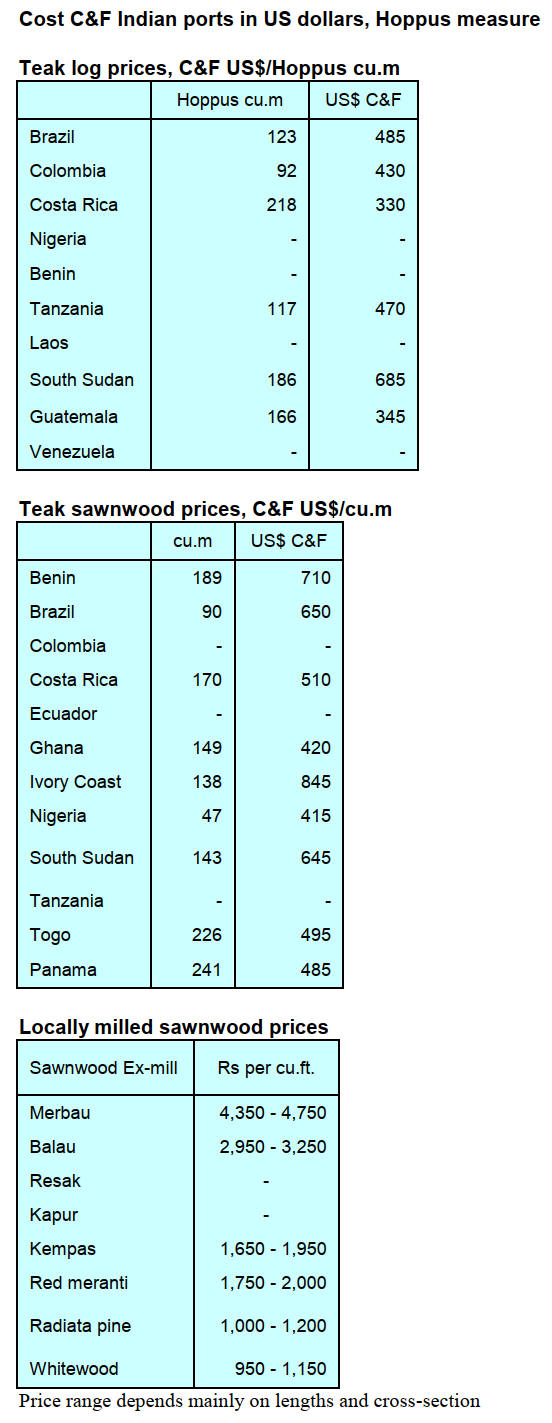 
7.
VIETNAM
Wood and wood product (W&WP)
trade highlights
According to Vietnam Customs in 2024 Vietnam’s
W&WP exports earned US$16.25 billion and NTFP
exports brought about US$1.024 billion, a year-on-year
growth of over 20%.
Vietnam’s W&WP exports to Canada in December 2024
has reached US$25.8 million, up 17% compared to
December 2023. In 2024 W&WP exports to Canada
generated US$253 million, up 23% compared to 2023.
In December 2024 exports of kitchen furniture were
valued at US$126 million, up 15% compared to December
2023. In 2024 exports of kitchen furniture earned US$1.4
billion, up 19% compared to 2023.
Vietnam's W&WP imports in December 2024 were
estimated at US$250 million, up 8% compared to
November 2024 and up 35% compared to December 2023.
In 2024 W&WP imports totalled US$2.75 billion, up 27%
compared to 2023.
Vietnam's oak imports in December 2024 were 31,500
cu.m worth US$19.2 million, up 9% in volume and 10% in
value compared to November 2024. Compared to
December 2023 imports increased by 53% in volume and
65% in value.
In 2024 oak imports were recorded at 371,300 cu.m,
worth
US$217.3 million, up 36% in volume and 44% in value
compared to 2023.
Wood product exports to reach US$18 bil. in 2025
Vietnam’s Department of Forestry under the Ministry of
Agriculture and Rural Development has projected a
positive outlook for wood and wood product exports in
2025, with a target of US$18 billion.
According to the General Department of Customs,
Vietnam's wood and wood product exports in 2024 were
estimated at US$16.25 billion, up 20% year-on-year. The
2024 result represents a significant milestone as it
surpassed the previous record of US$15.8 billion set in
2022.
These successes can be attributed to the proactive efforts
of businesses to seek new markets, participating in trade
fairs and exhibitions, transition from simply processing to
designing innovative products and enhancing product
quality, according to the General Department of Customs.
The recovery of consumer demand in major markets,
particularly the US and Europe, provided a significant
boost to exports. The Vietnamese wood industry also
made inroads into key markets and expanded its presence
in emerging markets such as the UAE and India.
Despite these positive outcomes the industry still faces
notable challenges.
Key issues include the need for stricter control over the
legal origin of wood, the risk of trade fraud, competition
from regional players and global economic fluctuations.
The US and the EU have imposed strict regulations on the
legal origin of wood requiring Vietnamese businesses to
improve supply chain oversight. Regional competitors
such as Indonesia, Thailand and Malaysia also pose
significant challenges, while potential economic
slowdowns in major markets could impact demand.
To address these issues, according to the General
Department of Customs, the industry must adapt to market
regulations, enhance product value and strengthen market
penetration strategies.
Ngo Sy Hoai, Vice Chairman and General Secretary of the
Vietnam Timber and Forest Products Association
(VIFOREST) has said that, with strong growth momentum
and collaborative efforts between businesses and
regulatory agencies, the industry is well-positioned to
achieve new milestones and strengthen its international
presence.
Prospects for 2025
The Department of Forestry has forecast that Vietnam’s
wood exports could reach US$18 billion in 2025.
However, success will depend on factors such as global
economic recovery, consumer demand in major markets,
evolving trade policies and the competitiveness of
Vietnamese enterprises.
The US remains the leading market for Vietnamese
wood
products but competition from suppliers like China,
Malaysia and Indonesia underscores the need for
Vietnamese businesses to focus on value-added products.
The EU market, supported by the Vietnam-EU Free Trade
Agreement (EVFTA), offers additional opportunities
through tariff advantages. Demand in China, driven by
urbanisation presents another avenue for expansion though
stricter origin requirements remain a challenge.
To meet the US$18 billion target Ngo Sy Hoai emphasised
the importance of trade promotion. He suggested that
businesses should leverage e-commerce platforms,
although bulky wooden products pose logistical challenges
for online sales. He urged the Trade Promotion
Department to prioritise e-commerce initiatives tailored
for the wood industry.
In addition, the industry is embracing digital and green
transformations to comply with the regulatory
requirements of key markets like the US and EU. At the
national level, Hoai called for the Ministry of Industry and
Trade to actively promote Vietnam’s commitment to
sustainable practices with the message “Vietnam’s wood
industry says no to illegal wood”.
Restoration of degraded forests
Vietnam is seeking solutions for the restoration of
degraded forests. Deputy Prime Minister, Tran Luu
Quang, signed Decision No. 993/QD-TTg approving the
national plan to implement the “Glasgow Declaration on
forests and land”.
The overall objective of the Plan is to contribute directly
to the goal of sustainable development which embraces
agriculture, rural area develpoment, greenhouse gas
emission reduction and climate change adaptation,
biodiversity conservation, sustainable forest management,
transition to green economy, circular economy, promotion
of sustainable livelihood development for local people and
communities, ensuring food security and environmental
protection.
Specific goals in Vietnam’s plan include the strict
management of the existing natural forest area, minimising
the conversion of natural forest and limit forest and land
degradation.
By 2030, the country aims to reverse deforestation, forest
and land degradation, ensure harmonisation of sustainable
development of agricultural and forestry production in
association with agricultural and rural development
effectively contributing to the implementation of the
commitment to reduce greenhouse gas emissions under the
national self-determination (NDC).
At the same time the country will strive for the area of
poor natural forests to be restored and upgraded by 10%
by 2025 and 20% by 2030 thus contributing to reducing
the proportion of poor natural forests.
See: https://www.vietnam.vn/en/phan-dau-dien-tich-rung-
tu-nhien-ngheo-duoc-phuc-hoi-dat-10-nam-2
Exhibitions in Vietnam 2025 - must-visit events
Vietnam’s wood industry is witnessing strong
development and 2025 promises to be a boom year with a
series of international wood exhibition events. Below are
some notable fairs and exhibitions that promise to attract a
lot of attention taking place in 2025 in Vietnam, opening
up many business opportunities for the domestic and
international industries.
HAWA EXPO 2025
5 – 7 March, 2025
Location: Ho Chi Minh
VIFA EXPO 2025
5 March, 2025
Location: Ho Chi Minh
Q.FAIR 2025
March 6 – 9, 2025
Location: Binh Dinh
VietnamWood 2025
19-22 November, 2025
Location: Ho Chi Minh
See: https://vietnamwood.com.vn/top-wood-exhibition-in-
vietnam-2025/
8. BRAZIL
Advances in Brazilian Forest
Management
The State of Mato Grosso plays a crucial role in mitigating
global warming through sustainable forest management,
contributing significantly to national timber production.
Pará and Mato Grosso States account for most of the
timber harvested in Brazil, representing about 80% of the
national timber production value and a production of 3.95
million cubic metres in 2023, according to the Brazilian
Institute of Geography and Statistics (IBGE). Forestry and
timber processing is the main driver of the economy in 66
municipalities in the State of Mato Grosso generating over
13,000 formal jobs.
The State's forest-based sector adopts strict traceability
processes through the Sisflora 2.0 system ensuring
environmental compliance and transparency in the
commercialiation of timber from natural forests.
In 2024, the Mato Grosso State exported approximately
201,900 tonnes of forestry products to 69 countries
generating a trade surplus of US$85.3 million. The key
markets included the G7 (US$29.3 million), European
Union (US$25.7 million), Asia (US$22.2 million) and
BRICS (US$20.4 million) according to the Ministry of
Agriculture, Livestock and Food Supply.
In 2024, France imported US$13.7 million worth of forest
products, purchasing 7,192 tonnes from the Mato Grosso
State. This marked significant growth over the past
decade.
Sales to France increased by over 70% over ten years and
by almost 4% year on year. India also expanded its
imports by 8%, purchasing 24,947 tonnes worth US$13.9
million.
Other significant markets in 2024 included the United
States (US$12.9 million), Belgium (US$6.5 million) and
China (US$5.2 million).
See: https://forestnews.com.br/mato-grosso-contribui-para-
mitigar-aquecimento-global-por-meio-do-manejo-florestal/
Plantations sector achieved highest contribution to
GDP in 11 years
According to the Food and Agriculture Organization
(FAO) processed wood consumption is projected to
increase by 37% between 2020 and 2050.
Timber resources from forest plantations help reduce
pressure on native forests and promote carbon dioxide
sequestration throughout the growth cycle of trees.
Industry leaders emphasise that forestry offers economic
and environmental benefits. In 2022, the Brazilian forest
plantations sector achieved its highest contribution to GDP
over the past 11 years.
The Brazilian Tree Industry (IBÁ) reports that 9 million
hectares of planted forests in Brazil have the capacity to
absorb 88 billion tonnes of CO2eq from the atmosphere.
In 2023, the area dedicated to tree planting exceeded 10
million hectares for the first time, with eucalyptus
accounting for 76% of this area followed by pine. As the
climate crisis intensifies the Brazilian timber industry has
adopted sustainable practices to meet global standards.
See: https://www.portaldoagronegocio.com.br/florestal/mercado-
florestal/noticias/mercado-madeireiro-no-brasil-espera-
crescimento-sustentavel-ate-2050
Export update, November and December 2024
November
In November 2024 Brazilian exports of wood-based
products (except pulp and paper) increased 40% in value
compared to November 2023, from US$258.2 million to
US$360.5 million.
Pine sawnwood exports increased 39% in value between
November 2023 (US$45.8 million) and November 2024
(US$63.6 million). In volume, exports increased 31% over
the same period, from 199,700 cu.m to 262,500 cu.m.
Tropical sawnwood exports increased 69% in volume,
from 18,400 cu.m in November 2023 to 31,100 cu.m in
November 2024. In value, exports increased 58% from
US$8.3 million to US$13.1 million over the same period.
Pine plywood exports increased 44% in value in
November 2024 compared to November 2023, from
US$50.3 million to US$72.3 million. In volume, exports
increased 39% over the same period, from 160,900 cu.m
to 223,300 cu.m.
As for tropical plywood, exports increased in volume by
13% and in value by 7%, from 2,400 cu.m and US$1.4
million in November 2023 to 2,700 cu.m and US$1.5
million in November 2024.
As for wooden furniture, the exported value increased
from US$49.3 million in November 2023 to US$58.9
million in November 2024, an increase of almost 20%.
December
In December 2024 Brazilian exports of wood-based
products (except pulp and paper) increased 14% in value
compared to December 2023, from US$276.4 million to
US$315.2 million.
Pine sawnwood exports increased 15% in value between
December 2023 (US$52.3 million) and December 2024
(US$60.0 million). In volume, exports increased 3% over
the same period, from 237,800 cu.m to 245,100 cu.m.
Tropical sawnwood exports increased 9% in volume, from
22,100 cu.m in December 2023 to 24,000 cu.m in
December 2024. In value, exports increased from US$9.1
million to US$9.4 million over the same period.
Pine plywood exports increased 37% in value in
December 2024 compared to December 2023, from
US$50.5 million to US$69.1 million. In volume, exports
increased 33% over the same period, from 165,700 cu.m
to 219,900 cu.m.
As for tropical plywood, exports increased in volume by
83% and in value by 73%, from 1,800 cu.m and US$1.1
million in December 2023 to 3,300 cu.m and US$1.9
million in December 2024, respectively.
As for wooden furniture, the exported value increased
from US$45.6 million in December 2023 to US$54.2
million in December 2024, an increase of 19%.
2024 export performance
The consolidated data from Brazil´s 2024 trade balance
indicate that, from January to December, compared to the
same period in 2023, total exports decreased by -0.8%,
amounting to US$337.0 billion, while imports grew by
9.0%, reaching US$262.48 billion, resulting in a trade
surplus of US$74.55 billion according to the Ministry of
Development, Industry and Foreign Trade (MDIC).
The mechanically processed timber sector maintained
relative stability with the United States and the European
Union as the main markets. The sector faced significant
challenges in 2024, including logistical and port-related
bottlenecks, strikes by officials involved in export
processes and the threat of dockworker strikes in the US.
According to the Brazilian Association of Mechanically
Processed Timber Industry (ABIMCI), inadequate
infrastructure and high operational costs hindered the
efficient transportation of wood products.
The complex logistical scenario directly affected export
volumes with numerous variables requiring immediate
solutions. Infrastructure improvements to make services
more efficient require medium- and long-term planning
and investment.
ABIMCI highlighted that, while a slight recovery in export
volumes occurred in the last few months of 2024, this was
primarily due to the clearance of backlogged shipments
rather than real growth.
Variations in exported volumes across segments reflected
factors such as seasonality, interest rates and the
performance of construction sector in key destination
markets like the United States and the European Union.
The sector remains vigilant regarding global market
fluctuations and is planning strategies for 2025 based on
consolidated data to address structural challenges and
sustain its competitiveness.
See: https://abimci.com.br/exportacoes-brasileiras-de-madeira-
em-2024-mostram-estabilidade-usa-e-europa-sao-os-principais-
mercados/
Pará State - largest exporter of tropical timber
The State of Pará continues to be Brazil's largest exporter
of native tropical timber despite the challenges faced by
the sector. After the COVID-19 the sector showed signs of
recovery in 2022 driven by markets such as the United
States and the European Union.
However, in 2023, Pará experienced 40% decline in
timber exports compared to the previous year totalling
US$212.8 million and 242,000 tonnes exported. In 2024,
overall exports decreased but exports of profiled wood
products grew with the US accounting for 54% of demand.
The Association of Timber Industries Exporters of Pará
State (AIMEX) highlighted key issues affecting the sector
including bureaucratic delays in issuance of permits and
licenses, as well as the 2024 IBAMA (Brazilian Institute
for Environment and Renewable Natural Resources) strike
which disrupted operations.
Another challenge has been the inclusion of Ipę and
Cumaru timber species in CITES Appendix II
complicating their export.
Despite these difficulties, the State of Pará leads the
national log production, logging 4.9 million cubic metres
or 44% of national production and an increase of 5%
compared to the previous year.
See: https://www.oliberal.com/economia/para-e-o-maior-
exportador-de-madeira-tropical-nativa-do-brasil-apesar-dos-
reveses-aponta-a-aimex-1.908555
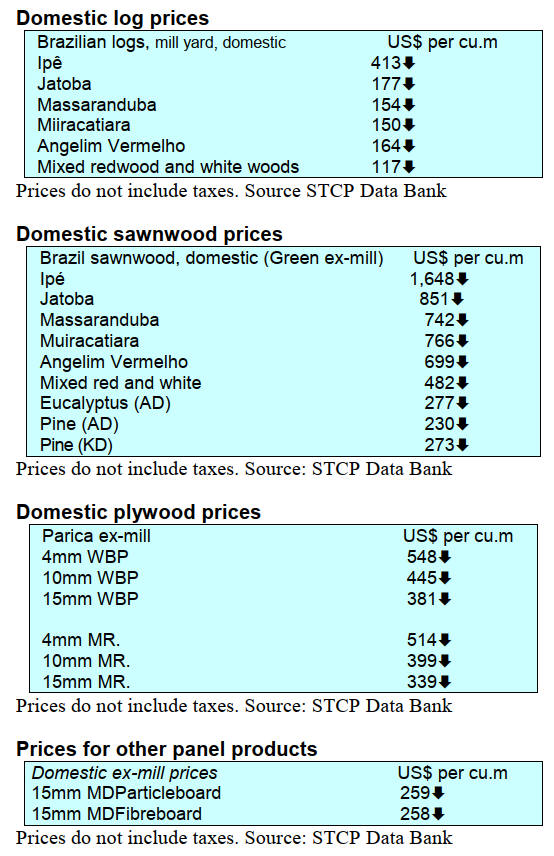
Export prices
Average FOB prices Belém/PA, Paranaguá/PR,
Navegantes/SC and Itajaí/SC Ports.
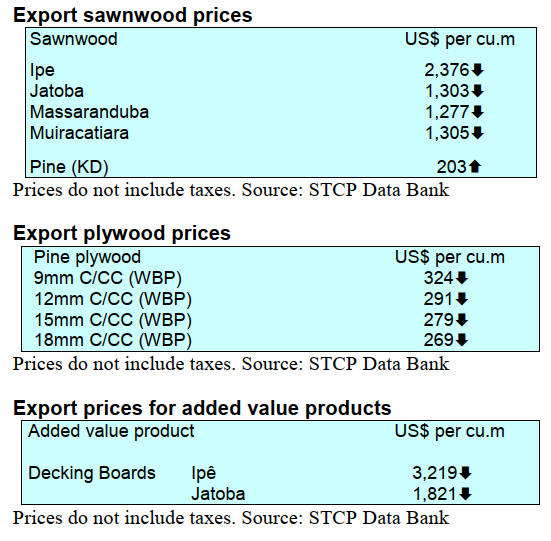
Through the eyes of industry
The latest GTI report lists the challenges identified by the
private sector in Brazil.
See: https://www.itto-
ggsc.org/static/upload/file/20250116/1737011307133693.pdf
9. PERU
Decline in export
earnings
Between January and November 2024 Peru's wood
product exports earned US$80.6 million, a drop of 13%
compared to the US$92.6 registered in the same period of
the previous year, reported the Association of Exporters
(ADEX).
ADEX detailed in its report that, in the first eleven months
of this year, the most important items exported were semi-
manufactured products at US$31 million with a share of
around 39% followed by sawnwood at US$25.9 million
and a share of 32%. Other products included firewood and
charcoal (US$ 6.8 million and an 8% share), construction
products (US$4.9 million and furniture and parts (US$4.5
million).
The main destinations were France (US$13.8 million), the
United States (US$14.4 million), China (US$10.8
million), the Dominican Republic (US$9.9 million) and
Mexico (US$9.7 million). Vietnam, Denmark, Belgium,
Chile and Germany completed the top ten market
destinations.
SERFOR approves stock declarations required in
advance of shihuahuaco and tahuarí exports
After verifying the information presented the National
Forestry and Wildlife Service (SERFOR) approved the
stock declarations submitted by the first group of
companies that will be permitted to export Dipteryx spp.
and Handroanthus spp. products.
SERFOR specialists conducted on site verification of the
stock declarations, the traceability of the wood product
from source, the accuracy of the data and the Forest
Transport Guide declarations. This process will continue
with the other companies that presented their stockdata
last year before the entry into force of CITES.
See: https://www.gob.pe/institucion/serfor/noticias/1090739-
serfor-aprueba-declaracion-de-stocks-para-exportar-shihuahuaco-
y-tahuari
Multi-sectoral Plan against forest fires
The President of the Council of Ministers highlighted that
the Multisectoral Plan against Forest Fires 2025-2027
ratifies the commitment to prioritise preventive measures.
This plan will strengthen protection of the environment
and the safety of citizens in the face of forest fire risks in
764 districts of the high Andean and Amazonian areas.
These measures are framed in three areas of action:
meteorological surveillance and investigation of the causes
of forest fires; risk reduction techniques and response
capacity to these fires.
The Disaster Risk Management Secretariat of the
Presidency of the Council of Ministers will be responsible
for monitoring compliance with the plan. Also, as part of
the Executive's commitment to transparency, these reports
will be published on the Peruvian State's Single Digital
Platform for Citizen Guidance.
Recovering degraded land
Representatives of Bosques Amazónicos held a workshop
with regional authorities and representatives of civil
society in Ucayali where they presented details of their
large-scale reforestation and restoration project with native
species.
The purpose of the meeting was to communicate the scope
of the initiative and to open the exchange of experiences
and knowledge as part of the process of involvement and
socialisation. The restoration project aims to recover more
than 10,000 hectares of degraded land through
reforestation with native species.
The meeting was attended by representatives of the Padre
Cote Cooperative, the Aidesep Ucayali Regional
Organization (ORAU), the Ucayali Agrarian Chamber, the
Peruvian Amazon Research Institute (IIAP), the National
Institute for Agrarian Innovation (INIA) and other
technical specialists from the region.
See: https://www.bosques-amazonicos.com/blog/en/large-scale-
reforestation-restoration-meeting-with-authorities-and-civil-
society-to-promote-sustainable-development-in-ucayali/
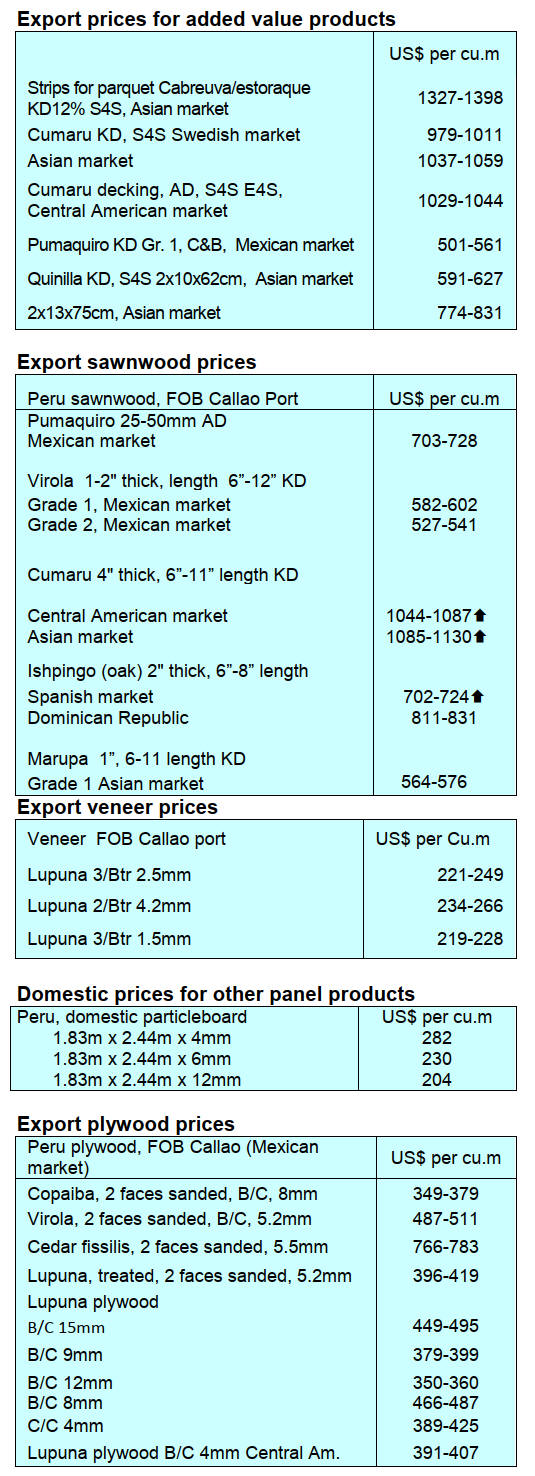

|